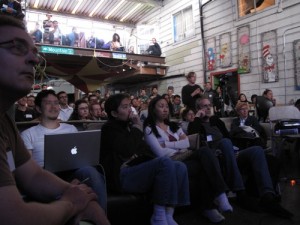What is The Quantified Self?
Gary Wolf
March 3, 2011
 With our first Quantified Self conference coming up, many people are learning about the Quantified Self for the first time. (Welcome, newcomers!) Here, I’ll give some of the history of the Quantified Self, with a focus on why we’re organized the way we are, and some ideas about how you can get the most out of the various things we do. I’ll also describe what we’ve got planned with a focus on the upcoming conference. This is the first in a series: Later posts will take up specific conference themes, and many different people will be contributing. I’ll keep a close eye out, so so if there’s a question about QS that you’d like to ask, please add it to the comments and one of us will reply.
With our first Quantified Self conference coming up, many people are learning about the Quantified Self for the first time. (Welcome, newcomers!) Here, I’ll give some of the history of the Quantified Self, with a focus on why we’re organized the way we are, and some ideas about how you can get the most out of the various things we do. I’ll also describe what we’ve got planned with a focus on the upcoming conference. This is the first in a series: Later posts will take up specific conference themes, and many different people will be contributing. I’ll keep a close eye out, so so if there’s a question about QS that you’d like to ask, please add it to the comments and one of us will reply.
Kevin Kelly and I founded The Quantified Self in 2007. We had both been involved in the early years of Wired magazine: he was the founding executive editor; I was one of the early writers. (Later I became the executive editor of the online part of the company.) At Wired, it was exciting to be part of cultural and technological exploration.
In 2007 we began looking at some new practices that seemed, loosely, to belong together: life logging, personal genomics, location tracking, biometrics. These new tools were being developed for many different reasons, but all of them had something in common: they added a computational dimension to ordinary existence. Some of this was coming from “outside,” as marketers and planners tried to find new ways to understand and influence us. But some of it was coming from “inside” as our friends and acquaintances tried to learn new things about themselves. We saw a parallel to the way computers, originally developed to serve military and corporate requirements, became a tool of communication. Could something similar happen with personal data? We hoped so.
Some things about QS were thoughtfully considered, but the most important thing was serendipitous. One day Kevin issued an open invitation for people who shared our interests to come to what we called a “Show&Tell” at his studio. We created a Quantified Self group on MeetUp and did no other publicity. Thirty people came. Many had projects that were absolutely fascinating. The depth of knowledge and the intensity of curiosity was mind blowing. Suddenly we understood what we were doing in a new way. We were making a users group.
The most famous users group in Silicon Valley was the Homebrew Computer Club, whose members contributed so much to making the personal computer. Another important inspiration for us is the now mostly forgotten Berkeley Macintosh Users Group (BMUG), which welcomed and instructed so many newcomers after the release of the first Macs. Users groups, when they succeed, are wonderful things; informal but deeply engaged learning communities operating outside the normal channels of academic and commercial authority. Here at the Quantified Self, we want to know what these new tools of self-tracking are good for, and we want to create an environment where this question can be explored on a human level.
Anybody can start a MeetUp, and while we’ve outlined some recommended practices in a document called “How To Start Your Own QS Show&Tell,” we don’t tell local groups what to do. If you have an idea you’d like to try, please let us know. We’ll do what we can to help. One new things to look out for later in the year is an online users guide to self tracking, supported by the Robert Wood Johnson Foundation. We hope that this guide will broaden the exchange between the more technologically oriented QS participants and those who are discovering these practices for the first time.
Right now we are focused on the conference coming up, with much work going on behind the scenes. Our intention is to extend the culture of collaborative learning that has been happening at the local meetings. Aside from very brief plenary sessions in the morning, both days will be taken up by breakout sessions, organized by topic and led by volunteers who have experience tracking mood, sleep, attention, weight loss, memory, fitness; or hacking sensors, making data visualizations, and designing self-experiments. Nearly forty breakouts have been suggested so far. You will hear more about them soon.
Your questions and suggestions are always welcome. Come to the conference and bring your curiosity – I look forward to meeting you there.


